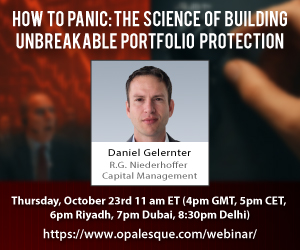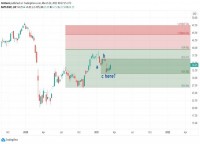|
The 7 Bad Habits of Islamic Funds
By Bernardo Vizcaino, CAIA
An occasional mistake in translating Arabic to English occurs with the word 'funds' which sometimes translates into the English language as 'boxes'. Nevertheless, it is a very accurate translation when it comes to Shariah compliant investment products. This is especially true when one considers the inhibited nature of their origination & manufacturing. Indeed they seem stuck in a box, constrained by some imaginary walls, being delivered in sporadic fashion with rather uninspired risk/return profiles. A sector that should be one of the strongest indicators of industry success in reality resembles a desert landscape, dry in ideas. New launches have understandably slowed in the backdrop of the global markets, but product diversity and sophistication still leaves much to talk about.
Some launches do shine, partly because of their pioneer status (often self-proclaimed) but also for their solitary existence, few others have deemed it worthwhile to follow on their ground-breaking footsteps. It seems that such inventive examples are like an oasis - a welcome sight for the thirsty investor but one that is not visited frequently enough. The fact is that their peers (either current or in the pipeline) are simply rare, product manufacturers apparently sucked into a quicksand of conformism. On the other end of the spectrum though, products which are deemed as innovative in nature are more likely to resemble a mirage - failing to deliver on their promise.
The culprits are scattered across the product development life-cycle, but these in turn highlight the great opportunities available in the marketplace for those willing to go the extra mile. Here we scrutinize several ‘objectionable’ habits found across the industry:
- Comfort Zones
- Beta in a Box
- Headless Chickens
- Re-Repackaging
- One Size Fits All
- Off-limits to Off-shore
- Distribution Dreamland
Comfort Zones
This is embedded in the fund manager psyche, stick to what you know and don’t push the boundaries. In effect, the majority of Islamic funds remain focused on asset or country-specific mandates (i.e. Saudi Arabia, Kuwait, Malaysia, Indonesia) and if they choose to take a regional approach it is simply to follow an indigenous requirement of their local market. In the Gulf region the three must-have products remain a Saudi-equity, a GCC-equity and some money market fabrication (murabaha perhaps). The light at the end of the tunnel rests with sukuk funds as they have gradually gained
popularity. Nonetheless, product differentiation is hard to come across, and herd mentality seems to remain as the order of the day.
Beta in a Box
Global mandates, despite their extra-large label, are similarly at fault having fallen head over heels for the classic top-down approach that has delivered mostly unexciting large caps: the 'expensive ETF' syndrome (market exposure - or beta - is not bad at all, as long as it is priced correctly). In a fund universe dominated by long-only investments it would seem imperative to move away from vanilla/sanitized solutions, placing greater importance on un-orrelation/sophistication. Some argue that as the credit crisis unfolds anything innovative is deemed off-limits. Nevertheless, the industry is chasing after brand names, labels, just plain monikers. Effectively, in the hunt for quantity and quality the product range is missing exactly those two aspects.
Headless Chickens
One might argue that boutiques often launch one specific or standalone product, mainly due to their limited resources and specific area of focus. However, this seems to be the norm even for large-scale operations and quite remarkably for some of the largest conventional players. With the exception of some established industry players, the concept of a
product range is non-existent. Fund construction with a portfolio approach (i.e. what does an investor need to buy) is almost unheard of and secondary to the commission-fueled machine of product delivery (i.e. what can be sold to investors). The opportunity is there for crafting solutions that straddle multiple asset classes, as opposed to navigating through an array of dispersed offerings.
Re-Repackaging
The hunt for a pure multi-manager solution continues, as current offerings struggle to justify their double fee structures (one at the single manager level and another at the fund of fund level). Then again, products following a global-diversified approach are uncannily similar, and they have all succeeded in diversifying away idiosyncratic risk but excess returns having been diversified away as well. The issue is worsened with in-house wholesale products, which carry an inherent bias towards selecting internal products (why choose those from competitors), the value of independent and objective fund selection is somehow lost in the marketfuelled noise.
One Size Fits All
A common misconception from industry outsiders is the notion that all Islamic investors are the same, a monochromatic approach that regrettably is present within the industry as well. It appears that it is far too complex to launch multiple share classes so as to simultaneously cater to: retail/institutional investors, specific currency-hedging requirements, liquidity preferences and management of dividends. The priority is to sanitize an offering with risk/ return characteristics often left totally unaddressed. How telling that the industry is mesmerized by the intricacies of some exotics yet separate share classes are shunned as if the balance of the cosmos might be somehow altered.
Off-limits to Off-shore
It is incomprehensible that one of the most important trade flows of the past few decades has not been openly acknowledged by participants in either side of the Indian Ocean. If one considers the various synergies between the GCC and Southeast Asia regions, it boggles the mind that cross-jurisdictional products haven’t become standard operating procedure. Dual listings are very rare and to add insult to injury a ready-made offshore jurisdiction lies underutilized in the extensive corporate infrastructure available in Labuan. Even offshore products (mostly real estate in fact) are far more focused on their tax efficiencies rather than the ability to be offered across various borders. Products seem to be eternally destined to be either onshore or offshore, but seldom both.
Distribution Dreamland
Distribution networks have proven effective in delivering products within their core markets (GCC and Southeast Asia) but are often ignored by institutions that lack an effective presence in these regions. A number of managers thus fail to address product distribution from the outset, instead opting to leave this crucial detail to the very end. Time and again,
effectively reaching investors has been successful as long as an established network is already in place. For instance, the largest Syariah mutual funds in Indonesia are the newest launches (run by established non- Islamic fund houses) and DWS funds are distributed across the GCC via a conventional bank network. Joint ventures and distribution agreements should be customary, but for now this remains another unexplored trend in the industry.
Bad habits die hard, but great opportunities are available to those willing to break the mold. Some of these habits will persist far into the future but the industry will find it increasingly necessary to tackle each one of these limiting factors head on. In doing so, greener pastures will emerge in places where there was only but sand.
| 




 RSS
RSS










